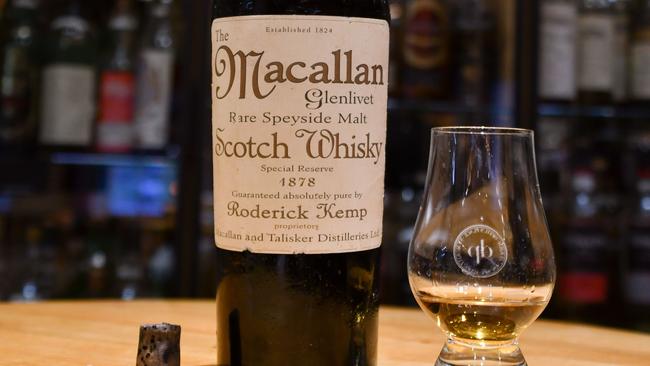St Andrews University scientists’ laser test can tell fake whisky from top drop
Scientists have developed a laser detection system that can tell whether a whisky is old, rare and worth thousands or a knock-off worth next to nothing.

Scientists have developed a laser detection system that can tell whether a whisky is old, rare and worth thousands of dollars or a knock-off worth next to nothing.
As the buying and selling of rare whiskies has become big business, so too has the market for counterfeiters using cheap blends to make millions.
Whereas previously some liquid had to be extracted via a syringe and needle for carbon dating, or even more liquid taken for chemical analysis, the new technology could revolutionise attempts to identify the fakes before the cork is pulled.
In 2017 Chinese millionaire Zhang Wei paid £7500 ($13,500) for a single dram of what he and the Hotel Waldhaus am See in St Moritz, Switzerland, thought was a Macallan 1878 single malt. Suspicions were raised when a photograph of the bottle’s label was published online. Carbon dating eventually proved that it was about 100 years younger than claimed and a lot less rare. The hotel manager flew to China to reimburse Mr Zhang, who had been none the wiser on tasting the whisky.
Graham Bruce, head researcher for the optical manipulation group at the University of St Andrews in Scotland, said the team’s normal work with lasers turned to whisky after Kishan Dholakia, their research leader, was inspired while walking past a whisky shop on his way home one night.
Nine years later and the team has perfected how to shine a laser through a bottle of whisky to collect the chemical fingerprints from the liquid’s molecules, without picking up interference from the glass.
This means they can detect dangerous chemicals in liquid which should not be there or match them to a specific sample held by a distillery of a rare malt.
Dr Bruce said the team hoped it would be developed for commercial use so that handheld devices could be used at border checks and by whisky merchants and collectors.
When you shine a beam of light at a substance it absorbs some of that light and scatters some, shifting its wavelength. By measuring the shift it is possible to work out the chemical make-up of the substance.
“Each molecule has a unique wavelength colour shift, like a fingerprint made of light,” Dr Bruce said.
The problem is that if you shine a laser at a glass bottle of whisky you will detect far more of the light scattering off the glass than from the liquid inside. To get around this the team worked out that by shining the laser beam through a piece of glass “shaped like a sharp ice-cream cone” it could bend the light into a ring shape. The ring of light gets smaller and smaller until it reaches a tight focal point.
The scientists put the whisky inside the bottle in the focal point of the laser beam and only collected the light scattered from this point, while ignoring the wider ring of light.
“It’s like taking a photograph of the bottle with this laser beam,” Dr Bruce said. “If you just crop your camera image so you no longer see the ring of light on the bottle, you no longer detect it in the data.”
In 2018, when the Scottish Universities Environmental Research Centre tested a batch of vintage Scotch whiskies, more than a third turned out to be fakes.





To join the conversation, please log in. Don't have an account? Register
Join the conversation, you are commenting as Logout